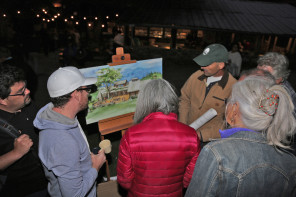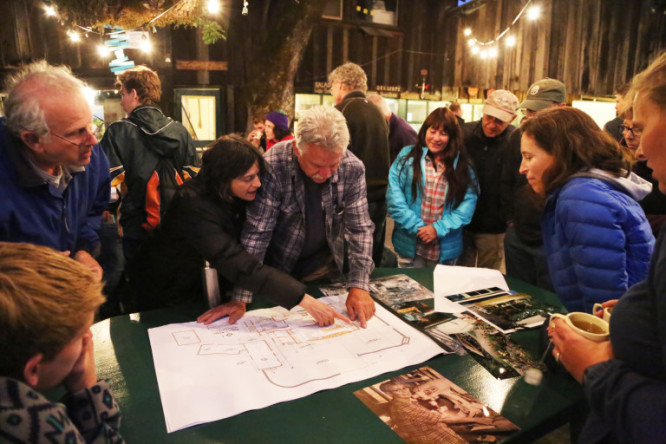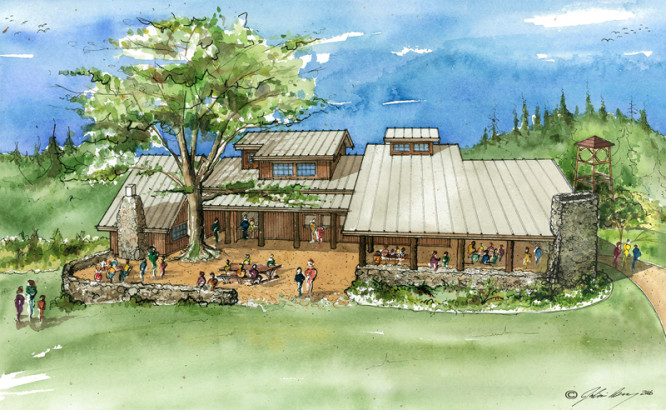For at least a century or two, many bears, black and brown, young and old, have patrolled the forests and meandered along the streams of the Bar 717 Ranch. In more recent decades, plenty of cuddly little Teddy Bears, a Pooh Bear or two, and a sweet Bear dog have endeared their way onto the platforms of Camp Trinity. But have you ever witnessed two California Golden Bears sitting on the eating platform under stately oak trees, staring at large sheets of paper spread out on a big green table, deep in animated conversation? Well, maybe you have, but you probably didn’t realize what you were seeing: it wasn’t diners dining nor old friends reminiscing but rather designers designing.


Both of these human designer Bears attended the University of California Berkeley, home to the Golden Bears, and each received his BA degree in Architecture from that esteemed institution of higher learning. You will almost certainly recognize one of the Golden Bears as the Director of Camp Trinity, Kent Collard. The other Golden Bear is Jack Freeman, of Hyampom and Eureka.
Kent, who grew up on the Bar 717 Ranch under the watchful eye of his mother Jean and grandparents Grover and Erma Gates, gained an early appreciation for “building things,” tinkering in the woodshop during the 1970’s and, as a young teenager, scouting tirelessly with his platform mates and counselor Eric Small for the perfect tree in which to build a tree house.
Jack, who from 7th grade on enjoyed mechanical drawing and knew that he wanted to study architecture, first came to Camp Trinity as a counselor in 1970 with the idea then of helping to design and build a suspension bridge over Hayfork Creek, a project which did not come to fruition at that time. But he did meet his future bride that summer, Marion Miller, whose sisters had left footprints on the barn hill dating way back to the 1950s. Together Jack and Marion staked their claim in Trinity County, bought property and a cabin along the south fork of the Trinity River in Hyampom, and built their own suspension bridge. It is a secluded place where they spend many long weekends and some weeks, though their main home and livelihoods are based in Eureka. Jack has a thriving architectural practice there while Marion practices law.
Since both Jack and Kent have had long associations with the Ranch, it was natural that they integrate their collective experiences and creativity and bring those combined insights to bear as the architects of the Kitchen Rebuild Project.
When Jack was asked recently about how the two designers are collaborating on the conception of the new kitchen, he replied, “Kent is great, relaxed, tuned in, and we tend to agree on solutions.” He further elaborated, “In the words of the great architect, I M Pei, ‘Good clients make good architecture.'”
While we might light-heartedly dub the Golden Bear team a Dynamic Duo, their sensitivities, insights into the requirements of the project, and communicative skills bring serious creative power and business acumen to the challenging task of redesigning an affordable space where some 600 meals a day are prepared while Camp is in session.
During a recent Question and Answer session they each responded as follows:
What interests you most about the project?
Kent: I am most interested in creating a better space for our kitchen staff to do their work. The existing space is cramped and cumbersome, and the workflow is inefficient. The result is extra work for every member of the crew. It is really hard work in there; hot, crowded, and physically demanding, with the inefficient use of space, low ceilings, narrow aisles, and too many steps.
Jack: Creating a facility that incorporates the Grover Gatesian vernacular with a functional, updated solution. I also have tremendous respect for the program made available to so many kids thanks to the commitment of Kent and Gretchen.
What do you see as the biggest challenges?
Jack: Scheduling is clearly the challenge here. Breaking ground immediately after the last Camp session this year and getting far enough along in construction to beat the weather.
Kent: The tight construction schedule. The kitchen is so important to the operation of camp, it’s really the one building we cannot do without. That means we can’t start the project until camp is over, and we have to have the new kitchen ready for the start of camp the next year. That leaves us nine and a half months for the demolition and construction. Also, much of the work will be occurring during the winter, which can be an added challenge…. Because camp is in such a remote location, it is always a challenge to find people to work. In interviewing Contractors, we are offering the option of us providing housing for them and their crews during the project. The distance to town for supplies is something we deal with all the time during the summer, and will also be an added challenge for any Contractors or their subs.
What features will be included to make the kitchen as “green” and energy efficient as possible?
Kent: The design for the new kitchen includes a double height belvedere over the stoves and cooking area. This will provide convective cooling ventilation without the need for large fans. That will save power and be quieter. The majority of the energy used in the new building will be for refrigeration and water heating. We will be replacing a whole fleet of [inefficient] chest freezers in the old kitchen with one walk-in unit in the new building. This, along with installing new, more efficient on-demand water heaters, will ensure huge energy savings in the new building
Jack: Energy efficient lighting and appliances, as well. A well insulated building with energy efficient heating systems and natural ventilation will provide a pleasant working kitchen.
Both Kent and Jack added that an array of solar panels may be a part of future renovations to Gates Gables kitchen, where that building’s south-facing roof provides an ideal orientation to maximize the benefit of a solar array.
Camp Trinity already has in place an aggressive recycling policy, where all glass and metals are separated and food waste is fed to the hogs so the addition of the energy-saving features of the new kitchen building with further reduce Camp’s carbon footprint.
Current and former campers and staff have grown accustomed to the natural-wood exterior and the comfortable “if-the-walls-could-talk” ambiance of the current kitchen building and dining area. A radically different appearance would kindle collective consternation, so the architects have been gone to great lengths to incorporate much the same layout and exterior appearance without sacrificing utility, creatively updating form and function. Many materials to be used in the construction of the building, much of the lumber and timbers for the log-frame structure, will come from trees salvaged from the Ranch property and milled on site.
What will be the exterior finishes most people notice while sitting under the apple trees?
Jack: The log frame and pole constructions along with stone walls and foundations will be the dominant architectural look of the building.
Kent: We love the existing building—the way it looks, if not always the way it functions. Like all the buildings at camp, the exterior of the kitchen is clad in 1X12 board and batten siding. Those 1X12 Douglas Fir boards used to be widely available, purchased by the truckload from the local mill. Now they are almost impossible to buy, and if you can find them, they are a special order and very expensive. Fortunately, we have Woodmizer bandsaw mill at camp. We can make just about any size board we need. Due to drought-related stress (lack of water and abundance of insects) we have a good supply of salvaged logs from the Ranch property. For the new kitchen, we will be milling up a big pile of 1X12 for the siding, along with a supply of Sugar Pine for some of the interior.

How long will the new building last?
Kent: Well, the exiting building has served camp for 85 years, and the new building will be built to much higher standards, so I would expect it to last for at least another 85 years.
Jack: How about 100 years? We are certainly not gravitating towards mediocre systems of construction.
The new kitchen will be built on virtually the same footprint as the current facility, between Leedy Lodge and the bell tower and include some nice additions, including two restrooms in a breezeway just off the eating platform as well as two guest quarters on the second story above the kitchen. But, thanks to the foresight of our California Golden Bears, the wonderful routered signs, as well as the iconic wooden spoon/fork (spork?) which lets us all know which utensil to save for dessert, will migrate to their new posts of duty over new kitchen windows.
Demolition of the old kitchen will start August 27, 2017 at the close of Alumni Camp, and construction should be well under way one year from today. Go Bears!
Researched and written by Bob Small, former camper and counselor; current member of the volunteer Advisory Board


That is a wonderfully told story of where we started and where we’re going with the hub of camp life (well, one of the hubs; another of mine is the barn.) Inspiration for last-minute additions to the building fund! Thanks.